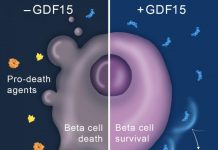October 2006 - The results of the world's first multicenter clinical trial of islet transplantation have confirmed the technique's potential benefits in patients with difficult-to-control type 1 (or "juvenile") diabetes.
Published in the September 28, 2006 issue of the New England Journal of Medicine, the international team of investigators report that the Edmonton Protocol for islet transplantation can safely and successfully promote long-term stabilization of blood sugar levels in "brittle" diabetes patients and in some cases, relieve them of the need for insulin injections altogether for at least two years.
The multicenter study, begun in 2001, studied 36 volunteers diagnosed with brittle type 1 diabetes: patients who, despite their best efforts, had wide, unpredictable fluctuations in their blood sugar levels. Using the Edmonton Protocol for type 1 diabetes, each participant received up to three infusions of donated insulin-producing islet cells at one of 9 participating clinical centers in the US, Canada and Europe. The study was sponsored by the Immune Tolerance Network (ITN), with funding and support from the Juvenile Diabetes Research Foundation (JDRF), the National Institute of Allergy and Infectious Diseases (NIAID) and the National Institute of Diabetes, Digestive and Kidney Diseases (NIDDK). NIAID and NIDDK are both components of the National Institutes of Health (NIH).
Investigators found that one year after receiving the final transplant, 72% (26/36) of patients had benefited from the technique, with 16 patients achieving freedom from insulin injections and 10 requiring insulin, but maintaining improved control of blood glucose levels. After two years, five of these 26 patients remained insulin independent, while the remainder continued to require less insulin by injection and showed improved measures of blood glucose control and reversal of hypoglycemic unawareness - a condition in which people with type 1 diabetes can no longer recognize the early symptoms of low blood sugar, thus making them vulnerable to sudden and severe confusion, loss of consciousness and seizures.
According to investigators, the results are a critical step in the development of islet transplantation as a potential treatment for type 1 diabetes.
Continue Reading Below ↓↓↓
"Not only does this show that islet transplantation can offer enormous benefits for brittle type 1 diabetes patients, but we now know that a single, standardized technique can be successfully applied at facilities around the world," Dr. Robert Goldstein, Chief Scientific Officer of the Juvenile Diabetes Research Foundation that helped fund the study. "This is yet another milestone for diabetes research."
The multicenter study followed from research published in the NEJM in 2000 by University of Alberta, Canada professor James Shapiro, who reported that 7 out of 7 patients who received the Edmonton Protocol were free from insulin injections 1 year after receiving the treatment.
According to Shapiro, who continued as leader of the multicenter study, its most important finding is the fact that even islet transplant recipients who never get off insulin or who return to insulin use over time show real improvement.
"This isn't an all-or-nothing procedure; it's not an issue of getting patients off insulin all together and keeping them that way. As we've shown, even partial survival of the transplanted islets can lead to significantly improved health in these patients. It's a tremendous result."
Patients enrolled in the study will be followed for at least another year to continue to assess the effects of the islet transplant procedure on their diabetes and overall health.
In their paper, the investigators reported no serious side effects related to the transplant procedure itself. Study related complications were generally a result of the immunosuppressive medications that patients are required to take in order to prevent the body from rejecting the transplanted islets. The development of safer, alternative means of preventing transplant rejection using "immune tolerance therapies" is a key JDRF research goal and the mission of the Immune Tolerance Network, the organization overseeing the study. Tolerance therapies are highly specific treatments that reprogram the immune system to prevent harmful immune responses, while leaving the disease-fighting capabilities of the immune system intact.
"The bottom line is that if islet transplantation is ever to become a viable treatment option for the majority of type 1 diabetes patients, we need new tolerance therapies." said Jeffrey A. Bluestone, PhD., ITN Director and Director of the Diabetes Center at University of California, San Francisco. "The results of this study give us the foothold that we need in order to investigate these safer alternatives to immunosuppression."
Such therapies may also provide additional advantages in islet transplantation, as the authors of the publication speculate that the immunosuppressive therapies could also contribute to the loss of islet function over time that led to loss of insulin independence in several of the patients.
Immune tolerance therapies are also being investigated for use as early interventions for type 1 diabetes. Several studies have now shown that they may slow or even prevent the destruction of islet cells that leads to type 1 diabetes and the dependence upon insulin injections.
The ITN is currently in the planning stages of follow-up studies designed to test emerging tolerance therapies in islet transplantation. Funding and support for clinical trials of tolerance therapies in early and established type 1 diabetes is available to researchers world-wide through the "ITN JDRF Partnership in Immune Tolerance" program.
Continue Reading Below ↓↓↓
In addition to the University of Alberta, other participating clinical sites participating in the study are located at the University of Minnesota, University of Miami, Harvard Medical School, Washington University, Pacific Northwest Research Institute, Justis-Liebig University in Giessen, Germany, San Raffaele Scientific Institute in Milan, Italy and University Hospital in Geneva, Switzerland.
Source: New England Journal of Medicine









